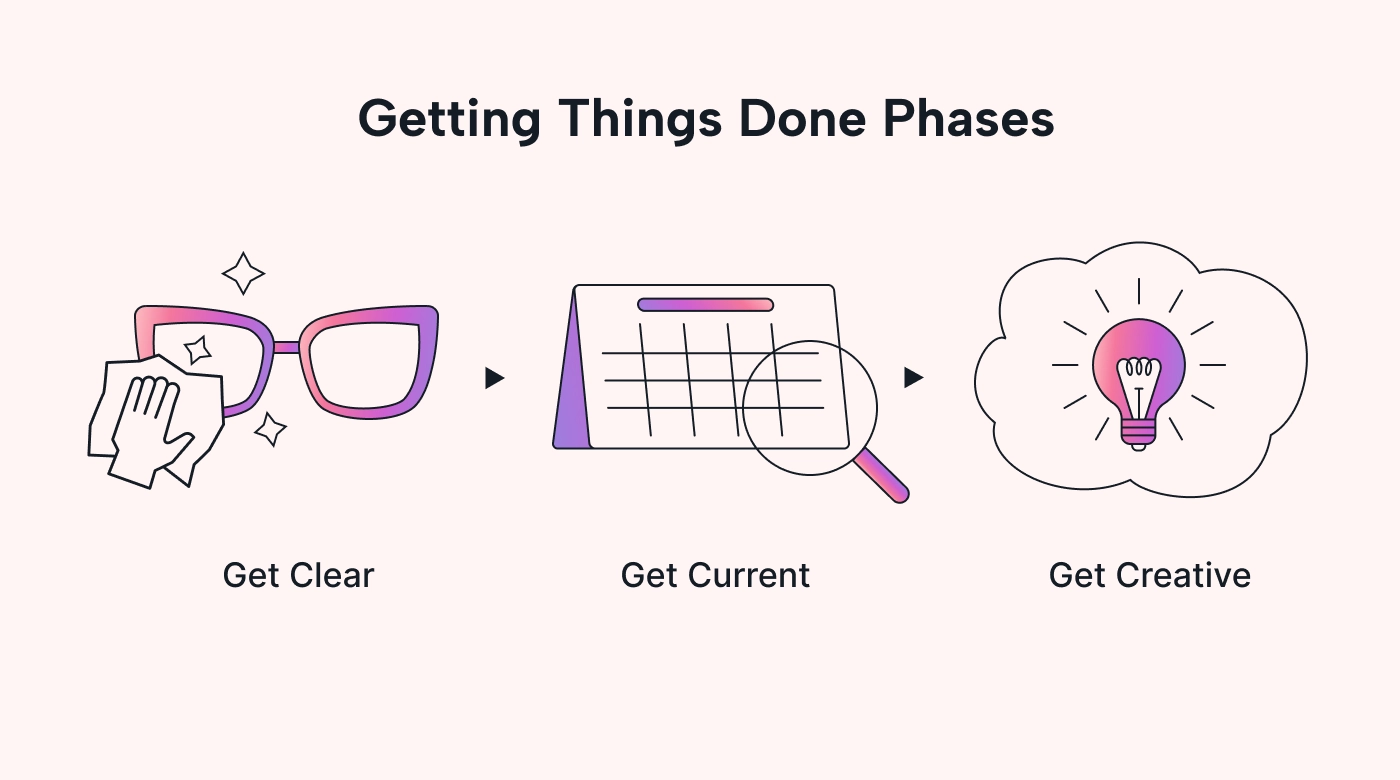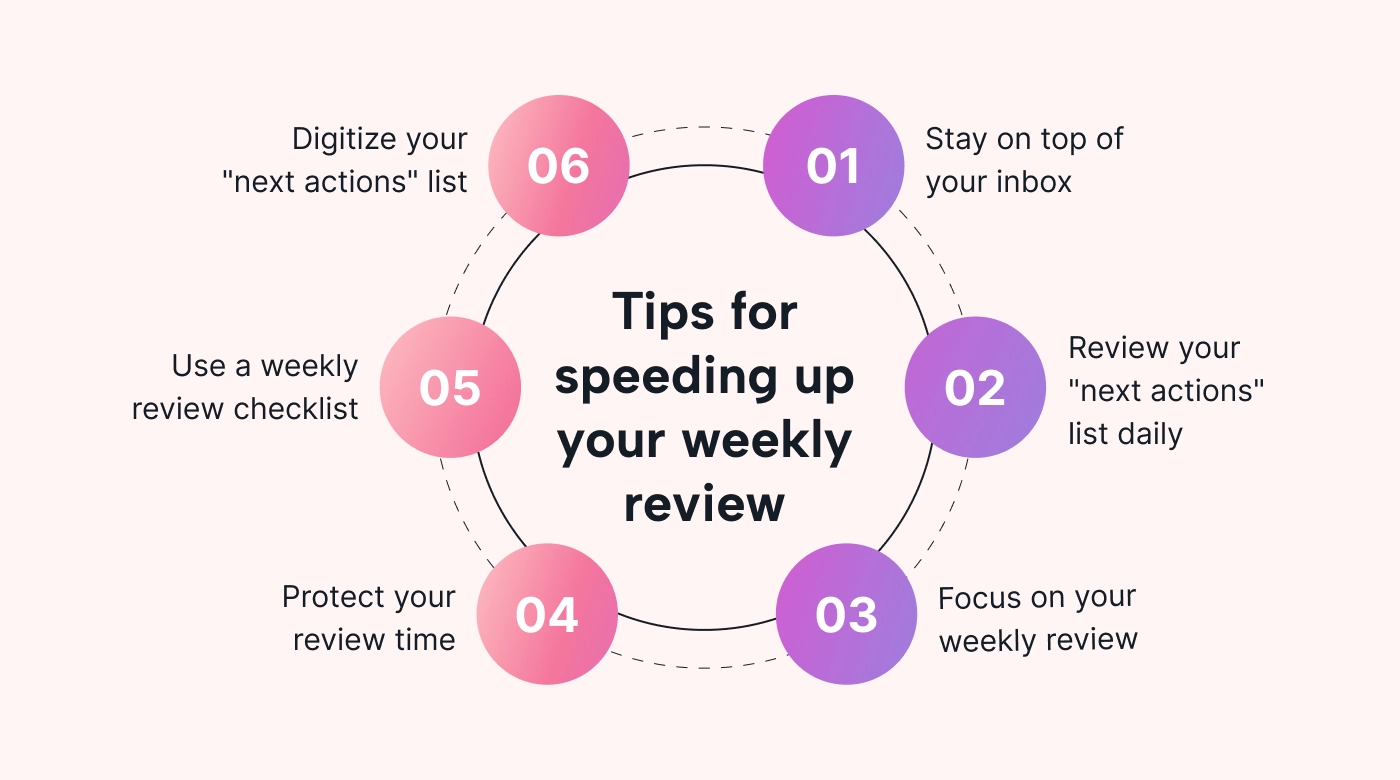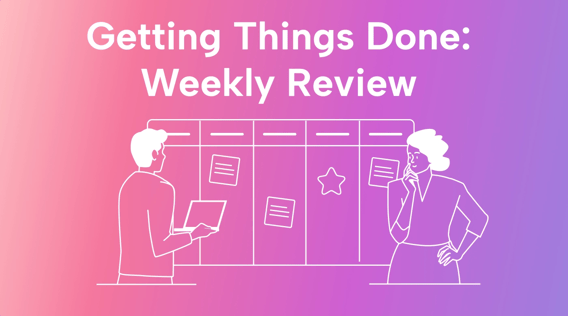One of the key components of the Getting Things Done (GTD) productivity method is the weekly review — intentional time spent reviewing the past week and figuring out how to replicate the good and avoid repeating the bad.
Unsurprisingly, this can take some time. And unfortunately, this is where most GTD users fall off the bandwagon.
You need to be diligent with your reviews if you want GTD to work.
If you’re ready to tackle your weekly reviews with confidence, then you’re in the right place. In this article, we dive into what weekly reviews are, what they’re supposed to accomplish, and the best ways to get through them as quickly as possible.
What is a weekly review?
A weekly review is time you set aside to go over the events and tasks of the past week to prepare for the upcoming seven days. During it, you will:
- Close any loops left open during the week
- Analyze the progress you made toward your medium- and long-term goals
- Assess how well your productivity system is working for you
- Plan adjustments you’ll make to your productivity system in the upcoming week
- Organize your priorities for the week ahead
- Outline the next steps for your ongoing projects and medium-term goals
What is a GTD weekly review?
GTD is a productivity method created by productivity specialist David Allen. It helps you transform chaotic thoughts into organized and actionable steps that build toward your long-term goals.
The weekly review is a key part of the GTD method. Every week, you organize the items on your “next actions” list and either delete, delegate, or schedule these small pieces of the larger productivity puzzle.
Allen describes three phases in the weekly review:
- Get clear
- Get current
- Get creative
 |
What are your goals when performing a weekly review?
You have three main goals when performing a weekly review:
- Close any loops from the previous week
- Set yourself up for the upcoming week
- Evaluate your productivity systems and make small adjustments where necessary
When should you review your week?
There isn't a one-size-fits-all perfect time to complete a weekly review. You can do it on any day — what’s important is that you have the self-discipline to be consistent every week.
Most GTD practitioners choose to perform their weekly reviews at the start or end of the work week. Doing them on Mondays, for instance, gives you time to ease into “work mode” after the weekend, helping you start the week on the right foot.
Doing these reviews on Fridays, on the other hand, means the week that has just passed is fresh in your mind. You’re in the midst of your priorities and know exactly what areas need the most attention and time — giving you context as you plan for the upcoming week.
Benefits of performing a weekly review
A weekly review can benefit you in the following ways:
- Prepares you for the upcoming week
- Speeds up your daily planning
- Improves your problem-solving skills
- Helps you remember to close loops from previous weeks
- Creates a habit of organization
- Helps you build a holistic, long-term understanding of your productivity level
- Helps you track your goals and progress toward them
How to perform a weekly review
Your weekly review creates space for reflection and honesty surrounding your habits and productivity. It’s your time to collect your thoughts and organize them in a way that encourages you to continue toward your goals.
To make your reviews as effective as possible, incorporate the following simple steps into them:
1. Choose a time, day, and place for your weekly review
Decide on a set location for your weekly review and dedicate a fixed block of time to the task.
As we mentioned earlier, there’s no right or wrong time to complete your weekly review. The key is to choose the same time, day, and place every single week. Doing this ensures you start the process the same way.
Choosing a regular time and day ahead of time also makes it less likely that you’ll procrastinate or avoid the task. Plus, it limits the number of decisions you have to make related to your weekly review, reserving your decision-making capacity for your planning session.
Related: Time Blocking 101: the Ultimate Guide
 |
2. Create a weekly review checklist
Your weekly review checklist outlines the steps you’ll work through during each review. The GTD method divides this checklist into the following three phases or sections:
Get clear: Empty your head and take note of any loose ends that need tying up.
- Gather and sort all documents relating to ongoing projects. This includes any notes you made while working or attending meetings related to the project. Organize them into project-specific piles (for loose papers) or files (for digital work).
- Process all emails and get to inbox zero. Inbox zero is a process where you delete, delegate, or schedule all actions called for within your emails and then clear your inbox entirely. It goes beyond deleting all your emails to record and organize all the action items in your emails and other messages.
- Offload all thoughts about the previous week. Without looking at your calendar, what from the past week feels unfinished? Is anything nagging at you?
- Offload all thoughts about the upcoming week. Without planning anything, what about the next week feels daunting? Is there anything you don’t want to forget about when you start planning your schedule?
Get current: Get all your items up-to-date and ready for the new week.
- Review your “next actions” list. This list contains all tasks that need to get done, sorted by context into categories.
- Make a note of all tasks that will roll over from last week. These include tasks you didn’t complete fully and new tasks related to the tasks you did complete.
- Sweep your past calendar. Look through the last two weeks and make a note of any appointments, meetings, or calls that require follow-up. Include a note describing the important details, like what you expect from the person you’re going to contact or details regarding your progress.
- Schedule your follow-ups. If you don’t follow up immediately, set a time and day to do so within the next week.
Get creative: Review and refine your productivity system to improve the following week.
- Analyze your someday/maybe list. Created by David Allen, your someday/maybe list stores all your ideas and dreams that you don’t have plans for yet. See if any of the items on this list can be actioned, and remove any that no longer align with your goals.
- Note any ideas or projects you’d like to start working on over the next week. Include important notes, like task dependencies or colleagues who’ll be involved.
- Sweep your future calendar. Look through the next three to four weeks to start mentally preparing for upcoming events, projects, tasks, important dates, or decisions you’ll need to make. Note any actions related to these items that you want to take in the next week, and include any important details, like contact numbers or the steps involved in a project.
- Schedule action. Choose a day and time to work on the action items you noted in your calendar sweep. If you don’t have time for non-urgent actions, leave a note to schedule them in your next weekly review.
- Identify and organize your priorities. Once you’ve compiled your follow-up task list and upcoming task list, organize them into categories of related tasks and mark them with importance levels (low, medium, or high).
3. Ask questions
Your weekly review is also the perfect time for reflection. Once you’ve organized the facts and logic related to the previous and upcoming weeks, it’s important to analyze your feelings and thoughts regarding your productivity and your productivity systems.
 |
Ask yourself a set of questions at the end of your weekly review to gauge how well your planning and productivity systems worked. Over time, you’ll gain invaluable insights into exactly what it takes for a week to feel successful.
Your questions could include the following:
- What went well in the past week?
- How can I build on the success of the things that went well?
- What didn’t go as well as I hoped it would in the past week? What result was I looking for, and what result did I get instead?
- How can I improve my efforts or adjust my approach to be more effective next time?
- What did I do this past week that moved me closer to my long-term goals?
Tips for speeding up your weekly review
Even if you’ve felt the benefits of your weekly reviews for yourself, you’d be in the minority if you said you don’t mind how long the process takes.
Fortunately, once your weekly review becomes a standard part of your routine, there are simple ways to streamline and speed up the process.
Let’s take a look:
 |
1. Stay on top of your inbox
Although getting to inbox zero forms part of the weekly review process, you can still aim to do it every day.
Set aside one or two time blocks daily to work through your email inbox and keep it clear. Don’t fall for the temptation of dealing with an email the minute it hits your inbox, though, as this leaves you open to distraction and can hinder your progress on high-value work.
2. Review your “next actions” list daily
Like reaching inbox zero, you can also review your “next actions” list every day. Make a note of the things on the list you could complete when you have a spare moment.
Whenever you finish a scheduled task sooner than anticipated, choose a task on your “next actions” list to complete. This keeps your momentum going and helps you avoid wasting time trying to think up something to do.
3. Focus on your weekly review
Monotasking (working on a single task at a time) is one of the best ways to speed up your weekly review and boost your overall productivity. Avoid common distractions to make it easy for yourself to concentrate fully on your review.
Don’t:
- Try to work on anything on your project list during the review
- Attempt to spread the review out and work on it in stages throughout the day
Set aside a block of time for review and get through it.
Motion makes this easy. It has an anti-self-destruction feature that gently guides you back to your task, keeping you efficient and productive.
4. Protect your review time
Distractions and interruptions can make the weekly review process take hours longer than it needs to.
When completing your weekly review, don’t respond to emails, answer calls, or allow any in-person interruptions outside of dire emergencies. Protecting this time gives you the best chance of working efficiently and powering through the review to finish it as quickly as possible.
Motion’s Intelligent Calendar guards this time for you by marking you as “busy” for the duration of your weekly review time block. Your colleagues won’t know the specifics of your activities, but they’ll know to leave you to it!
 |
5. Use a weekly review checklist
Although the checklist was outlined above, it’s important to reiterate how helpful it is to use the checklist every week. Include all steps of the review on a checklist, and work through each point.
Using a consistent review to-do list reduces the amount of thinking you have to do during the review itself. You’ll be much less likely to forget a task or important point because you have a list of reminders.
6. Digitize your “next actions” list
Take advantage of digital tools to make it easy to manage your “next actions” list. List all your tasks in Motion, and let it do the scheduling for you.
When you finish a time block or meeting earlier than you anticipated, adjust the time in your calendar. Motion will shift your tasks around and tell you exactly what to work on next.
If you have too many things on your “next actions” list, it can be difficult to choose what to start with. Motion does this thinking for you.
Complete your weekly reviews with Motion’s help
Performing weekly reviews may seem to require tremendous effort, but it doesn’t have to be that complicated. With a comprehensive checklist, a streamlined system, and a dedicated hour, you can analyze the previous week and prepare for the next one with ease.
Motion is a powerful task manager and AI-powered calendar that helps you organize your schedule in a way that reflects your priorities and protects your marked-off time from interruptions. If you’re looking to streamline your weekly review and cut out hours of planning every month, Motion is the best tool for the job.
Try Motion for free today.

Haylee is a versatile writer with ten years of experience. With a background in marketing and writing for large SaaS companies, Haylee brings her passion for the written word to diverse projects ranging from blog posts and ebooks to direct marketing campaigns.




